Scores for 2024 AP Exams will be available starting July 8. View the educator schedule for more information.

AP English Language and Composition Exam Questions
Free-response questions and scoring information.
Download free-response questions from this year's exam and past exams along with scoring guidelines, sample responses from exam takers, and scoring distributions.
If you are using assistive technology and need help accessing these PDFs in another format, contact Services for Students with Disabilities at 212-713-8333 or by email at [email protected] .
2024: Free-Response Questions
| Questions | Scoring | Samples and Commentary |
|---|---|---|
|
|
--> |
--> |
2023: Free-Response Questions
| Questions | Scoring | Samples and Commentary |
|---|---|---|
|
|
|
2022: Free-Response Questions
| Questions | Scoring | Samples and Commentary |
|---|---|---|
|
|
|
|
2021: Free-Response Questions
| Questions | Scoring | Samples and Commentary |
|---|---|---|
|
|
|
|
2020: Free-Response Questions
Note: The table below features a selection of free-response questions and related scoring information from the 2020 exam. You can find all of the 2020 FRQs and corresponding scoring information in AP Classroom .
| Prompts and Samples | Scoring Commentaries | Scoring Information |
|---|---|---|
| |
|
|
| |
|
|
| |
|
|
|
| ||
2019: Rescored Free-Response Questions
| Samples | Commentaries | Scoring Guidelines | |
|---|---|---|---|
| Questions originally from the 2019 exam |
|
|
2019: Free-Response Questions
| Questions | Scoring | Samples and Commentary |
|---|---|---|
|
|
|
2018: Rescored Free-Response Questions
| Samples | Commentaries | Scoring Guidelines | |
|---|---|---|---|
| Questions originally from the 2018 exam |
|
|
|
2018: Free-Response Questions
| Questions | Scoring | Samples and Commentary |
|---|---|---|
|
|
2017: Free-Response Questions
| Questions | Scoring | Samples and Commentary |
|---|---|---|
|
|
|
|
2016: Free-Response Questions
| Questions | Scoring | Samples and Commentary |
|---|---|---|
|
|
|
|
2015: Free-Response Questions
| Questions | Scoring | Samples and Commentary |
|---|---|---|
|
|
|
|
2014: Free-Response Questions
| Questions | Scoring | Samples and Commentary |
|---|---|---|
|
|
|
|
2013: Free-Response Questions
| Questions | Scoring | Samples and Commentary |
|---|---|---|
|
|
|
|
2012: Free-Response Questions
| Questions | Scoring | Samples and Commentary |
|---|---|---|
|
|
|
|
2011: Free-Response Questions
| Questions | Scoring | Samples and Commentary |
|---|---|---|
|
|
|
|
2011: Form B
| Questions | Scoring | Samples and Commentary |
|---|---|---|
|
|
|
|
2010: Free-Response Questions
| Questions | Scoring | Samples and Commentary |
|---|---|---|
|
|
|
|
2010: Form B
| Questions | Scoring | Samples and Commentary |
|---|---|---|
|
|
|
|
2009: Free-Response Questions
| Questions | Scoring | Samples and Commentary |
|---|---|---|
|
|
|
|
2009: Form B
| Questions | Scoring | Samples and Commentary |
|---|---|---|
|
|
|
|
2008: Free-Response Questions
| Questions | Scoring | Samples and Commentary |
|---|---|---|
|
|
|
|
2008: Form B
| Questions | Scoring | Samples and Commentary |
|---|---|---|
|
|
|
|
2007: Free-Response Questions
| Questions | Scoring | Samples and Commentary |
|---|---|---|
|
|
|
|
2007: Form B
| Questions | Scoring | Samples and Commentary |
|---|---|---|
|
|
|
|
2006: Free-Response Questions
| Questions | Scoring | Samples and Commentary |
|---|---|---|
|
|
|
|
2006: Form B
| Questions | Scoring | Samples and Commentary |
|---|---|---|
|
|
|
|
2005: Free-Response Questions
| Questions | Scoring | Samples |
|---|---|---|
|
|
|
|
2005: Form B
| Questions | Scoring | Samples |
|---|---|---|
|
|
|
|
2004: Free-Response Questions
| Questions | Scoring | Samples |
|---|---|---|
|
|
|
|
2004: Form B
| Questions | Scoring | Samples |
|---|---|---|
|
|
|
|
2003: Free-Response Questions
| Questions | Scoring | Samples |
|---|---|---|
|
|
|
|
2003: Form B
| Questions | Scoring | Samples |
|---|---|---|
|
|
|
|
2002: Free-Response Questions
| Questions | Scoring | Samples |
|---|---|---|
|
|
|
|
2002: Form B
| Questions | Scoring | Samples |
|---|---|---|
|
|
|
|
2001: Free-Response Questions
| Questions | Scoring | Samples |
|---|---|---|
|
|
|
|
2000: Free-Response Questions
| Questions | Scoring | Samples |
|---|---|---|
|
|
|
|
1999: Free-Response Questions
| Questions | Scoring | Samples |
|---|---|---|
|
|
|
|
Are you seeking one-on-one college counseling and/or essay support? Limited spots are now available. Click here to learn more.
How to Write the AP Lang Argument Essay (With Example)
December 14, 2023
We’d like to let you in on a little secret: no one, including us, enjoys writing timed essays. But a little practice goes a long way. If you want to head into your AP English Exam with a cool head, you’ll want to know what you’re getting into ahead of time. We can’t promise the AP Lang Argument Essay will ever feel like an island vacation, but we do have tons of hand tips and tricks (plus a sample essay!) below to help you do your best. This article will cover: 1) What is the AP Lang Argumentative Essay? 2) AP Lang Argument Rubric 3) AP Lang Argument Sample Prompt 4) AP Lang Argument Essay Example 5) AP Lang Argument Essay Example: Answer Breakdown.
What is the AP Lang Argument Essay?
The AP Lang Argument Essay is one of three essays included in the written portion of the AP English Exam. The full AP English Exam is 3 hours and 15 minutes long, with the first 60 minutes dedicated to multiple-choice questions. Once you complete the multiple-choice section, you move on to three equally weighted essays that ask you to synthesize, analyze, and interpret texts and develop well-reasoned arguments. The three essays include:
Synthesis essay: You’ll review various pieces of evidence and then write an essay that synthesizes (aka combines and interprets) the evidence and presents a clear argument. Read our write-up on How to Write the AP Lang Synthesis Essay here.
Argumentative essay: You’ll take a stance on a specific topic and argue your case.
Rhetorical essay: You’ll read a provided passage, then analyze the author’s rhetorical choices and develop an argument that explains why the author made those rhetorical choices. Read our write-up on How to Write the AP Lang Rhetorical Essay here.
AP Lang Argument Essay Rubric
The AP Lang Argument Essay is graded on 3 rubric categories : Thesis, Evidence and Commentary, and Sophistication . How can you make sure you cover all three bases in your essay? We’ll break down each rubric category with dos and don’ts below:
- Thesis (0-1 point)
When it comes to grading your thesis, AP Exam graders are checking off a box: you either have a clear thesis or you don’t. So, what crucial components of a thesis will get you your check mark?
- Make sure your thesis argues something . To satisfy your graders, your thesis needs to take a clear stance on the issue at hand.
- Include your thesis statement in your intro paragraph. The AP Lang Argumentative essay is just that: an essay that makes an argument, so make sure you present your argument right away at the end of your first paragraph.
- A good test to see if you have a thesis that makes an argument for your AP Lang Argumentative Essay: In your head, add the phrase “I agree/disagree that…” to the beginning of your thesis. If what follows doesn’t logically flow after that phrase (aka if what follows isn’t an agreement or disagreement), it’s likely you’re not making an argument.
- In your thesis, outline the evidence you’ll cover in your body paragraphs.
AP Lang Argument Essay Rubric (Continued)
- Avoid a thesis that merely restates the prompt.
- Avoid a thesis that summarizes the text but does not make an argument.
- Avoid a thesis that weighs the pros and cons of an issue. Your job in your thesis is to pick a side and stick with it.
- Evidence and Commentary (0-4 points)
This rubric category is graded on a scale of 0-4 where 4 is the highest grade. Unlike the rhetorical and synthesis essays, the evidence you need to write your AP Lang Argument Essay is not provided to you. Rather, you’ll need to generate your own evidence and comment upon it.
What counts as evidence?
Typically, the AP Lang Argument Essay prompt asks you to reflect on a broad cultural, moral, or social issue that is open to debate. For evidence, you won’t be asked to memorize and cite statistics or facts. Rather, you’ll want to bring in real-world examples of:
- Historical events
- Current-day events from the news
- Personal anecdotes
For this essay, your graders know that you’re not able to do research to find the perfect evidence. What’s most important is that you find evidence that logically supports your argument.
What is commentary?
In this essay, it’s important to do more than just provide examples relevant evidence. After each piece of evidence you include, you’ll need to explain why it’s significant and how it connects to your main argument. The analysis you include after your evidence is commentary .
- Take a minute to brainstorm evidence that logically supports your argument. If you have to go out of your way to find the connection, it’s better to think of different evidence.
- Include multiple pieces of evidence. There is no magic number, but do make sure you incorporate more than a couple pieces of evidence that support your argument.
- Make sure you include more than one example of evidence, too. Let’s say you’re working on an essay that argues that people are always stronger together than apart. You’ve already included an example from history: during the civil rights era, protestors staged group sit-ins as a powerful form of peaceful protest. That’s just one example, and it’s hard to make a credible argument with just one piece of evidence. To fix that issue, think of additional examples from history, current events, or personal experience that are not related to the civil rights era.
- After you include each piece of evidence, explain why it’s significant and how it connects to your main argument.
- Don’t summarize or speak generally about the topic. Everything you write must be backed up with specific and relevant evidence and examples.
- Don’t let quotes speak for themselves. After every piece of evidence you include, make sure to explain and connect the evidence to your overarching argument.
AP Lang Argument Essay (Continued)
- Sophistication (0-1 point)
According to the College Board , one point can be awarded to AP Lang Argument essays that achieve a high level of sophistication. You can accomplish that in four ways:
- Crafting a nuanced argument by consistently identifying and exploring complexities or tensions.
- Articulating the implications or limitations of an argument by situating it within a broader context.
- Making effective rhetorical choices that consistently strengthen the force and impact of the student’s argument.
- Employing a style that is consistently vivid and persuasive.
In sum, this means you can earn an additional point for going above and beyond in depth, complexity of thought, or by writing an especially persuasive, clear, and well-structured essay. In order to earn this point, you’ll first need to do a good job with the fundamentals: your thesis, evidence, and commentary. Then, to earn your sophistication point, follow these tips:
- Outline your essay before you begin to ensure it flows in a clear and cohesive way.
- Include well-rounded evidence. Don’t rely entirely on personal anecdotes, for example. Incorporate examples from current events or history, as well.
- Thoroughly explain how each piece of evidence connects to your thesis in order to fully develop your argument.
- Explore broader implications. If what you’re arguing is true, what does that mean to us today? Who is impacted by this issue? What real-world issues are relevant to this core issue?
- Briefly explore the other side of the issue. Are the instances where your argument might not be true? Acknowledge the other side, then return to proving your original argument.
- Steer clear of generalizations (avoid words like “always” and “everyone”).
- Don’t choose an argument you can’t back up with relevant examples.
- Avoid complex sentences and fancy vocabulary words unless you use them often. Long, clunky sentences with imprecisely used words are hard to follow.
AP Lang Argument Sample Prompt
The sample prompt below is published online by the College Board and is a real example from the 2021 AP English Exam. The prompt provides background context, essay instructions, and the text you need to analyze.
Suggested time—40 minutes.
Many people spend long hours trying to achieve perfection in their personal or professional lives. Similarly, people often demand perfection from others, creating expectations that may be challenging to live up to. In contrast, some people think perfection is not attainable or desirable.
Write an essay that argues your position on the value of striving for perfection.
In your response you should do the following:
- Respond to the prompt with a thesis that presents a defensible position.
- Provide evidence to support your line of reasoning.
- Explain how the evidence supports your line of reasoning.
- Use appropriate grammar and punctuation in communicating your argument.
AP Lang Argument Essay Example
As the old phrase says, “Practice makes perfect.” But is perfection something that is actually attainable? Sometimes, pushing for perfection helps us achieve great things, but most often, perfectionism puts too much pressure on us and prevents us from knowing when we have done the best we can. Striving for perfection can only lead us to shortchange ourselves. Instead, we should value learning, growth, and creativity and not worry whether we are first or fifth best.
Students often feel the need to be perfect in their classes, and this can cause students to struggle or stop making an effort in class. In elementary and middle school, for example, I was very nervous about public speaking. When I had to give a speech, my voice would shake, and I would turn very red. My teachers always told me “relax!” and I got Bs on Cs on my speeches. As a result, I put more pressure on myself to do well, spending extra time making my speeches perfect and rehearsing late at night at home. But this pressure only made me more nervous, and I started getting stomach aches before speaking in public.
Once I got to high school, however, I started doing YouTube make-up tutorials with a friend. We made videos just for fun, and laughed when we made mistakes or said something silly. Only then, when I wasn’t striving to be perfect, did I get more comfortable with public speaking.
AP Lang Argumentative Essay Example (Continued)
In the world of art and business and science, perfectionism can also limit what we are able to achieve. Artists, for example, have to take risks and leave room for creativity. If artists strive for perfection, then they won’t be willing to fail at new experiments and their work will be less innovative and interesting. In business and science, many products, like penicillin for example, were discovered by accident. If the scientist who discovered penicillin mold growing on his petri dishes had gotten angry at his mistake and thrown the dishes away, he would never have discovered a medicine that is vital to us today.
Some fields do need to value perfection. We wouldn’t like it, for example, if our surgeon wasn’t striving for perfection during our operation. However, for most of us, perfectionism can limit our potential for learning and growth. Instead of trying to be perfect, we should strive to learn, innovate, and do our personal best.
AP Lang Argument Essay Example: Answer Breakdown
The sample AP Lang Argumentative Essay above has some strengths and some weaknesses. Overall, we would give this essay a 3 or a 4. Let’s break down what’s working and what could be improved:
- The essay offers a thesis that makes a clear argument that is relevant to the prompt: “Striving for perfection can only lead us to shortchange ourselves. Instead, we should value learning, growth, and creativity and not worry whether we are first or fifth best.”
- The first body paragraph provides evidence that supports the essay’s thesis. This student’s personal anecdote offers an example of a time when perfectionism led them to shortchange themselves.
- The second body paragraph provides additional evidence that supports the essay’s thesis. The example describing the discovery of penicillin offers another example of a situation in which perfectionism might have limited scientific progress.
- The writer offers commentary explaining how her examples of public speaking and penicillin illustrate that we should “value learning, growth, and creativity” over perfectionism.
- The essay follows one line of reasoning and does not stray into tangents.
- The essay is organized well with intro, body, and concluding paragraphs. Overall, it is easy to read and is free of grammar errors.
What could be improved:
- Although the second body paragraph provides one good specific example about the discovery of penicillin, the other examples it offers about art and business are only discussed generally and aren’t backed up with evidence. This paragraph would be stronger if it provided more examples. Or, if this writer couldn’t think of examples, they could have left out mentions of art and business altogether and included alternate evidence instead.
- This writer would more thoroughly support their argument if they were able to offer one more example of evidence. They could provide another personal anecdote, an example from history, or an example from current events.
- The writer briefly mentions the other side of the argument in their concluding paragraph: “Some fields do need to value perfection. We wouldn’t like it, for example, if our surgeon wasn’t striving for perfection during our operation.” Since it’s so brief a mention of the other side, it undermines the writer’s overall argument. This writer should either dedicate more time to reflecting on why even surgeons should “value learning, growth, and creativity” over perfectionism, or they should leave these sentences out.
AP Lang Argument Essay Example—More Resources
Looking for more tips to help you master your AP Lang Argumentative Essay? Brush up on 20 Rhetorical Devices High School Students Should Know and read our Tips for Improving Reading Comprehension .
If you’re ready to start studying for another part of the AP English Exam, find more expert tips in our How to Write the AP Lang Synthesis and How to Write the AP Lang Rhetorical Essay blog posts.
- High School Success
Christina Wood
Christina Wood holds a BA in Literature & Writing from UC San Diego, an MFA in Creative Writing from Washington University in St. Louis, and is currently a Doctoral Candidate in English at the University of Georgia, where she teaches creative writing and first-year composition courses. Christina has published fiction and nonfiction in numerous publications, including The Paris Review , McSweeney’s , Granta , Virginia Quarterly Review , The Sewanee Review , Mississippi Review , and Puerto del Sol , among others. Her story “The Astronaut” won the 2018 Shirley Jackson Award for short fiction and received a “Distinguished Stories” mention in the 2019 Best American Short Stories anthology.
- 2-Year Colleges
- Application Strategies
- Best Colleges by Major
- Best Colleges by State
- Big Picture
- Career & Personality Assessment
- College Essay
- College Search/Knowledge
- College Success
- Costs & Financial Aid
- Data Visualizations
- Dental School Admissions
- Extracurricular Activities
- Graduate School Admissions
- High Schools
- Homeschool Resources
- Law School Admissions
- Medical School Admissions
- Navigating the Admissions Process
- Online Learning
- Outdoor Adventure
- Private High School Spotlight
- Research Programs
- Summer Program Spotlight
- Summer Programs
- Teacher Tools
- Test Prep Provider Spotlight
“Innovative and invaluable…use this book as your college lifeline.”
— Lynn O'Shaughnessy
Nationally Recognized College Expert
College Planning in Your Inbox
Join our information-packed monthly newsletter.
What are your chances of acceptance?
Calculate for all schools, your chance of acceptance.
Your chancing factors
Extracurriculars.
How to Write the AP Lang Argument Essay + Examples
What’s covered:, what is the ap language argument essay, tips for writing the ap language argument essay, ap english language argument essay examples, how will ap scores impact my college chances.
In 2023, over 550,148 students across the U.S. took the AP English Language and Composition Exam, and 65.2% scored higher than a 3. The AP English Language Exam tests your ability to analyze a piece of writing, synthesize information, write a rhetorical essay, and create a cohesive argument. In this post, we’ll be discussing the best way to approach the argumentative essay section of the test, and we’ll give you tips and tricks so you can write a great essay.
The AP English Language Exam as of 2023 is structured as follows:
Section 1: 45 multiple choice questions to be completed in an hour. This portion counts for 45% of your score. This section requires students to analyze a piece of literature. The questions ask about its content and/or what could be edited within the passage.
Section 2: Three free response questions to be completed in the remaining two hours and 15 minutes. This section counts for 55% of your score. These essay questions include the synthesis essay, the rhetorical essay, and the argumentative essay.
- Synthesis essay: Read 6-7 sources and create an argument using at least three of the sources.
- Rhetorical analysis essay: Describe how a piece of writing evokes meaning and symbolism.
- Argumentative essay: Pick a side of a debate and create an argument based on evidence. In this essay, you should develop a logical argument in support of or against the given statement and provide ample evidence that supports your conclusion. Typically, a five paragraph format is great for this type of writing. This essay is scored holistically from 1 to 9 points.
Do you want more information on the structure of the full exam? Take a look at our in-depth overview of the AP Language and Composition Exam .
Although the AP Language Argument may seem daunting at first, once you understand how the essay should be structured, it will be a lot easier to create cohesive arguments.
Below are some tips to help you as you write the essay.
1. Organize your essay before writing
Instead of jumping right into your essay, plan out what you will say beforehand. It’s easiest to make a list of your arguments and write out what facts or evidence you will use to support each argument. In your outline, you can determine the best order for your arguments, especially if they build on each other or are chronological. Having a well-organized essay is crucial for success.

2. Pick one side of the argument, but acknowledge the other side
When you write the essay, it’s best if you pick one side of the debate and stick with it for the entire essay. All your evidence should be in support of that one side. However, in your introductory paragraph, as you introduce the debate, be sure to mention any merit the arguments of the other side has. This can make the essay a bit more nuanced and show that you did consider both sides before determining which one was better. Often, acknowledging another viewpoint then refuting it can make your essay stronger.
3. Provide evidence to support your claims
The AP readers will be looking for examples and evidence to support your argument. This doesn’t mean that you need to memorize a bunch of random facts before the exam. This just means that you should be able to provide concrete examples in support of your argument.
For example, if the essay topic is about whether the role of the media in society has been detrimental or not, and you argue that it has been, you may talk about the phenomenon of “fake news” during the 2016 presidential election.
AP readers are not looking for perfect examples, but they are looking to see if you can provide enough evidence to back your claim and make it easily understood.
4. Create a strong thesis statement
The thesis statement will set up your entire essay, so it’s important that it is focused and specific, and that it allows for the reader to understand your body paragraphs. Make sure your thesis statement is the very last sentence of your introductory paragraph. In this sentence, list out the key points you will be making in the essay in the same order that you will be writing them. Each new point you mention in your thesis should start a paragraph in your essay.
Below is a prompt and sample student essay from the May 2019 exam . We’ll look at what the student did well in their writing and where they could improve.
Prompt: “The term “overrated” is often used to diminish concepts, places, roles, etc. that the speaker believes do not deserve the prestige they commonly enjoy; for example, many writers have argued that success is overrated, a character in a novel by Anthony Burgess famously describes Rome as a “vastly overrated city,” and Queen Rania of Jordan herself has asserted that “[b]eing queen is overrated.”
Select a concept, place, role, etc. to which you believe that the term “overrated” should be applied. Then, write a well-developed essay in which you explain your judgment. Use appropriate evidence from your reading, experience, or observations to support your argument.
Sample Student Essay #1:
[1] Competition is “overrated.” The notion of motivation between peers has evolved into a source of unnecessary stress and even lack of morals. Whether it be in an academic environment or in the industry, this new idea of competition is harmful to those competing and those around them.
[2] Back in elementary school, competition was rather friendly. It could have been who could do the most pushups or who could get the most imaginary points in a classroom for a prize. If you couldn’t do the most pushups or win that smelly sticker, you would go home and improve yourself – there would be no strong feelings towards anyone, you would just focus on making yourself a better version of yourself. Then as high school rolled around, suddenly applying for college doesn’t seem so far away –GPA seems to be that one stat that defines you – extracurriculars seem to shape you – test scores seem to categorize you. Sleepless nights, studying for the next day’s exam, seem to become more and more frequent. Floating duck syndrome seems to surround you (FDS is where a competitive student pretends to not work hard but is furiously studying beneath the surface just like how a duck furiously kicks to stay afloat). All of your competitors appear to hope you fail – but in the end what do you and your competitor’s gain? Getting one extra point on the test? Does that self-satisfaction compensate for the tremendous amounts of acquired stress? This new type of “competition” is overrated – it serves nothing except a never-ending source of anxiety and seeks to weaken friendships and solidarity as a whole in the school setting.
[3] A similar idea of “competition” can be applied to business. On the most fundamental level, competition serves to be a beneficial regulator of prices and business models for both the business themselves and consumers. However, as businesses grew increasingly greedy and desperate, companies resorted to immoral tactics that only hurt their reputations and consumers as a whole. Whether it be McDonald’s coupons that force you to buy more food or tech companies like Apple intentionally slowing down your iPhone after 3 years to force you to upgrade to the newest device, consumers suffer and in turn speak down upon these companies. Similar to the evolved form of competition in school, this overrated form causes pain for all parties and has since diverged from the encouraging nature that the principle of competition was “founded” on.
The AP score for this essay was a 4/6, meaning that it captured the main purpose of the essay but there were still substantial parts missing. In this essay, the writer did a good job organizing the sections and making sure that their writing was in order according to the thesis statement. The essay first discusses how competition is harmful in elementary school and then discusses this topic in the context of business. This follows the chronological order of somebody’s life and flows nicely.
The arguments in this essay are problematic, as they do not provide enough examples of how exactly competition is overrated. The essay discusses the context in which competition is overrated but does not go far enough in explaining how this connects to the prompt.
In the first example, school stress is used to explain how competition manifests. This is a good starting point, but it does not talk about why competition is overrated; it simply mentions that competition can be unhealthy. The last sentence of that paragraph is the main point of the argument and should be expanded to discuss how the anxiety of school is overrated later on in life.
In the second example, the writer discusses how competition can lead to harmful business practices, but again, this doesn’t reflect the reason this would be overrated. Is competition really overrated because Apple and McDonald’s force you to buy new products? This example could’ve been taken one step farther. Instead of explaining why business structures—such as monopolies—harm competition, the author should discuss how those particular structures are overrated.
Additionally, the examples the writer used lack detail. A stronger essay would’ve provided more in-depth examples. This essay seemed to mention examples only in passing without using them to defend the argument.
It should also be noted that the structure of the essay is incomplete. The introduction only has a thesis statement and no additional context. Also, there is no conclusion paragraph that sums up the essay. These missing components result in a 4/6.
Now let’s go through the prompt for a sample essay from the May 2022 exam . The prompt is as follows:
Colin Powell, a four-star general and former United States Secretary of State, wrote in his 1995 autobiography: “[W]e do not have the luxury of collecting information indefinitely. At some point, before we can have every possible fact in hand, we have to decide. The key is not to make quick decisions, but to make timely decisions.”
Write an essay that argues your position on the extent to which Powell’s claim about making decisions is valid.
In your response you should do the following:
- Respond to the prompt with a thesis that presents a defensible position.
- Provide evidence to support your line of reasoning.
- Explain how the evidence supports your line of reasoning.
- Use appropriate grammar and punctuation in communicating your argument.
Sample Student Essay #2:
Colin Powell, who was a four star general and a former United States Secretary of State. He wrote an autobiography and had made a claim about making decisions. In my personal opinion, Powell’s claim is true to full extent and shows an extremely valuable piece of advice that we do not consider when we make decisions.
Powell stated, “before we can have every possible fact in hand we have to decide…. but to make it a timely decision” (1995). With this statement Powell is telling the audience of his autobiography that it does not necessarily matter how many facts you have, and how many things you know. Being able to have access to everything possible takes a great amount of time and we don’t always have all of the time in the world. A decision has to be made with what you know, waiting for something else to come in while trying to make a decision whether that other fact is good or bad you already have a good amount of things that you know. Everyone’s time is valuable, including yours. At the end of the day the decision will have to be made and that is why it should be made in a “timely” manner.
This response was graded for a score of 2/6. Let’s break down the score to smaller points that signify where the student fell short.
The thesis in this essay is clearly outlined at the end of the first paragraph. The student states their agreement with Powell’s claim and frames the rest of their essay around this stance. The success in scoring here lies in the clear communication of the thesis and the direction the argument will take. It’s important to make the thesis statement concise, specific, and arguable, which the student has successfully done.
While the student did attempt to provide evidence to support their thesis, it’s clear that their explanation lacks specific detail and substance. They referenced Powell’s statement, but did not delve into how this statement has proven true in specific instances, and did not provide examples that could bring the argument to life.
Commentary is an essential part of this section’s score. It means explaining the significance of the evidence and connecting it back to the thesis. Unfortunately, the student’s commentary here is too vague and does not effectively elaborate on how the evidence supports their argument.
To improve, the student could use more concrete examples to demonstrate their point and discuss how each piece of evidence supports their thesis. For instance, they could discuss specific moments in Powell’s career where making a timely decision was more valuable than waiting for all possible facts. This would help illustrate the argument in a more engaging, understandable way.
A high score in the “sophistication” category of the grading rubric is given for demonstrating a complex understanding of the rhetorical situation (purpose, audience, context, etc.), making effective rhetorical choices, or establishing a line of reasoning. Here, the student’s response lacks complexity and sophistication. They’ve simply agreed with Powell’s claim and made a few general statements without providing a deeper analysis or effectively considering the rhetorical situation.
To increase sophistication, the student could explore possible counterarguments or complexities within Powell’s claim. They could discuss potential drawbacks of making decisions without all possible facts, or examine situations where timely decisions might not yield the best results. By acknowledging and refuting these potential counterarguments, they could add more depth to their analysis and showcase their understanding of the complexities involved in decision-making.
The student could also analyze why Powell, given his background and experiences, might have come to such a conclusion, thus providing more context and showing an understanding of the rhetorical situation.
Remember, sophistication in argumentation isn’t about using fancy words or complicated sentences. It’s about showing that you understand the complexity of the issue at hand and that you’re able to make thoughtful, nuanced arguments. Sophistication shows that you can think critically about the topic and make connections that aren’t immediately obvious.
Now that you’ve looked at an example essay and some tips for the argumentative essay, you know how to better prepare for the AP English Language and Composition Exam.
While your AP scores don’t usually impact your admissions chances , colleges do care a lot about your course rigor. So, taking as many APs as you can will certainly boost your chances! AP scores can be a way for high-performing students to set themselves apart, particularly when applying to prestigious universities. Through the process of self-reporting scores , you can show your hard work and intelligence to admissions counselors.
That said, the main benefit of scoring high on AP exams comes once you land at your dream school, as high scores can allow you to “test out” of entry-level requirements, often called GE requirements or distribution requirements. This will save you time and money.
To understand how your course rigor stacks up, check out CollegeVine’s free chancing engine . This resource takes your course rigor, test scores, extracurriculars, and more, to determine your chances of getting into over 1600 colleges across the country!
Related CollegeVine Blog Posts


AP® English Language
The ultimate guide to 2012 ap® english language frqs.
- The Albert Team
- Last Updated On: March 1, 2022
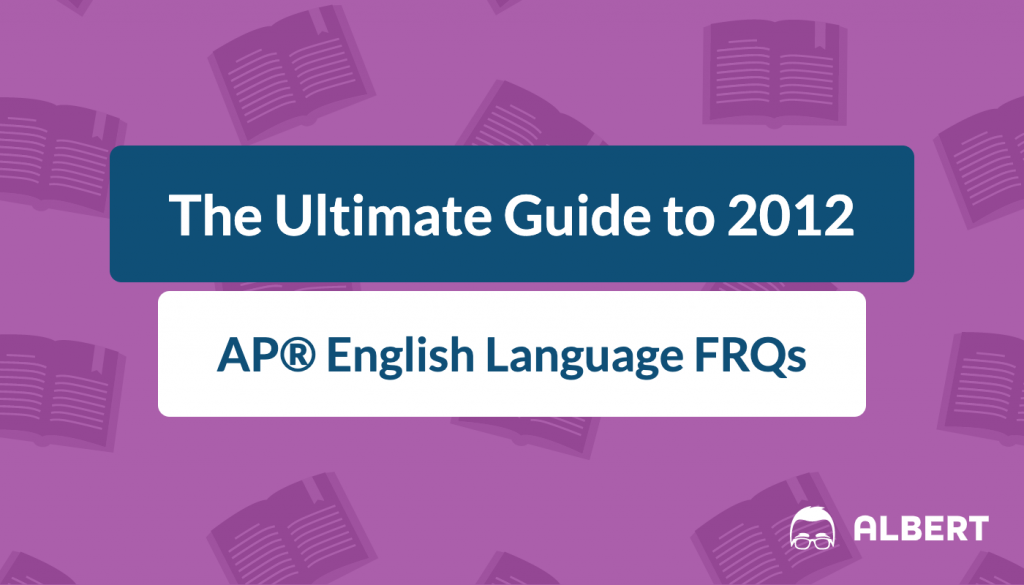
In no time, it’ll be here. Will you be ready? The AP® English Language and Composition exam is tough but not impossible. Sure, you must study hard and write as many essays as possible to succeed, but a few handy tips and some guidance goes a long way in preparing you for what to expect. To do well on the AP® English Language and Composition exam, you’ll need to write organized, substantive essays. Specifically, you must write an argument defending your position, using sources provided in the Free Response Question section along with your experience and knowledge.
The AP® English Language and Composition exam consists of two parts. The first consists of 52 to 55 multiple choice questions worth 45% of the total test grade. This section tests your ability to read and answer questions about a host of nonfiction subjects and rhetorical texts. The second section worth 55% of the total score requires essay responses to three questions, demonstrating your ability to analyze, comprehend, synthesize, and cite a variety of nonfiction materials in a well-structured argument. Exam takers have fifteen minutes to read the sources and the remaining two hours to write three essays.
By the time you take the test, you should know how to write a clear, organized essay that argues a claim. Beginning with a brief introduction that includes the thesis statement, you’ll use newspaper, journal, magazine articles, excerpts, or visuals in body paragraphs that support your claim. Pulling quotes and details from the sources, you’ll discuss how your support connects with your thesis statement, and then conclude by reiterating the thesis statement without repeating it. Clear organization, specific support, and full explanations or discussions are three critical components of high-scoring essays.
General Tips for the AP® English Language and Composition FRQs
Your teacher may have already told you how to approach the essays, but it’s important to keep the following in mind coming into the exam:
- Carefully read, review, and underline key to-do’s in the prompt.
- Briefly outline where you’re going to hit each prompt item–in other words, pencil out a specific order.
- Be sure you have a clear thesis or claim that responds to the call of the instructions, given the available evidence for support.
- Identify the sources used as support in your essay by author and title or the letter A, B, or C, etc.
- Use quotes, paraphrases, and statistics—lots of them—to exemplify your points throughout the essay.
- Fully explain or discuss how your examples support your claim. A deeper, fuller, and focused explanation of fewer items is better than a shallow discussion of more items (shotgun approach).
- Avoid making vague, general statements or merely summarizing the sources cited in support of your claim.
- Use transitions to connect sentences and paragraphs.
- Write in the present tense with generally good grammar.
- Keep your introduction and conclusion short, and don’t repeat your thesis verbatim in your conclusion.
The previously-released 2012 sample AP® English Language and Composition exam questions, sample responses, and grading rubrics are valuable learning tools. It’s instructive to analyze the three sample essays for each of the three FRQ essays and zero in on the differences between what AP® readers deem a high, medium, and low scoring essay. In that way, you’ll know what to do and what to avoid come test time.
Free Response Question #1
The subject in the first FRQ of the 2012 exam is the United States Postal Service. The prompt requires exam takers to use three of the seven provided sources to argue the following:
- Whether the USPS should restructure to meet modern demands
- What the USPS should do to meet modern demands
To model successful strategies, you want to break down the CollegeBoard’s three sample answers: the high scoring (A) essay, the mid-range scoring (B) essay, and the low scoring (C) essay. Together, they’re a road map to a high score on the rhetorical analysis essay.
Start with a Succinct Introduction that Includes Your Claim
All three essays present their claims in the introductory paragraph. All three also defend the proposition that the USPS should restructure to fit the times. However, the A essay, unlike the other two, structures the introduction to both inform and pique interest. For example, the introduction begins discussing the background of the issue with commonly known facts about the world’s increasing technological dependence. Then, the essay funnels or scopes to narrow to the claim in the last sentence to launch the argument.
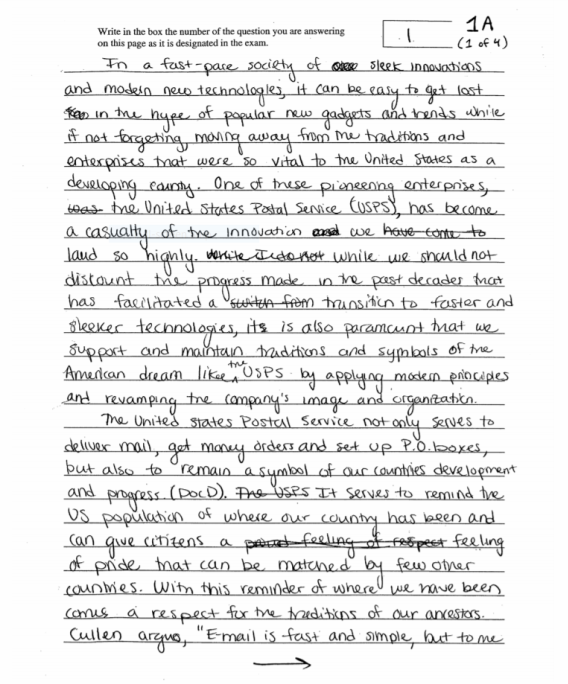
The B example also spurs interest with an anecdote to warm the reader to the subject of the essay. Unlike the A essay, however, this one positions the claim in the middle of a long introduction that begins discussing the supporting points that belong in the body paragraphs.
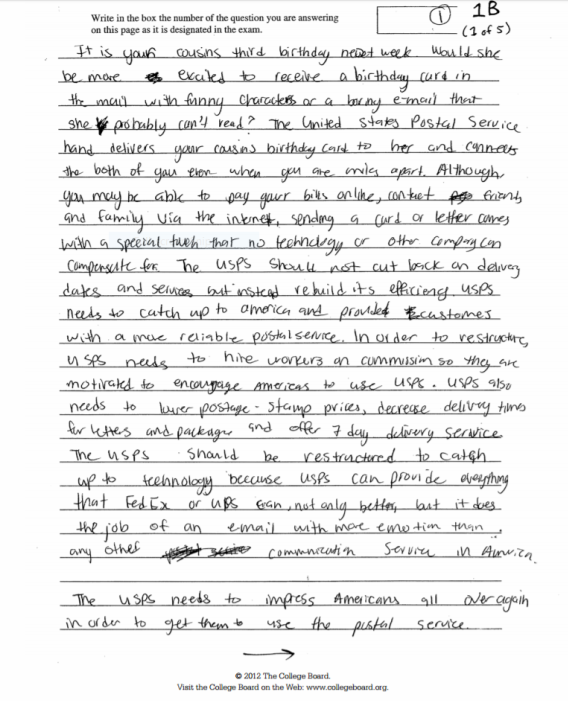
The B introduction previews the essay argument to guide the reader, but not as clearly as the A essay, although far more completely than the C, which merely states the claim in general terms, “for the following reasons”.
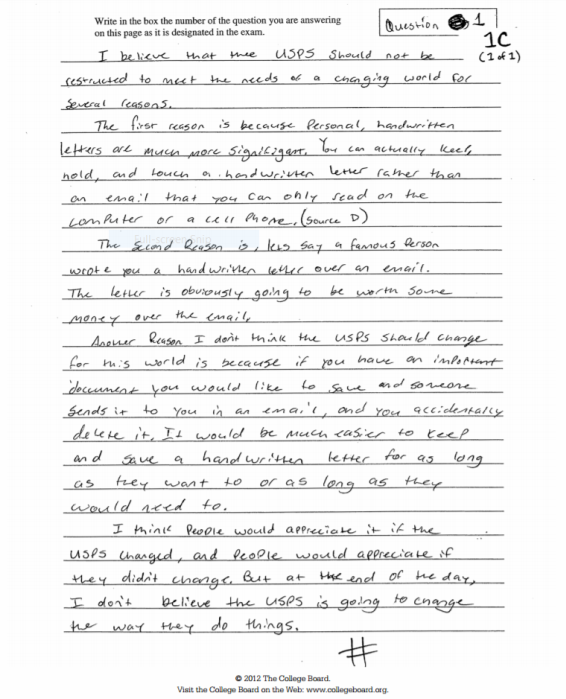
In sum, make introductions focused, compact, and precise. Good introductions inform, spark interest, and focus the essay’s main idea in an organized paragraph.
Use Source Facts and Opinions to Support Your Argument Points and Discuss them
The A answer models how to begin each paragraph with a clear topic sentence that furthers the claim and then adeptly supports the topic sentence. In the introduction, the A writer asserts the USPS is a symbol as well as a provider of postal services. Logically, the first paragraph begins with proving that assertion. The second sentence explains and exemplifies how the USPS is a symbol. Afterward, the student seamlessly weaves together assertions, quotes or paraphrases, and discussion in dense paragraphs. Sources are introduced by author or in parenthetical citations. Since economy is critical, the writer makes every sentence count.
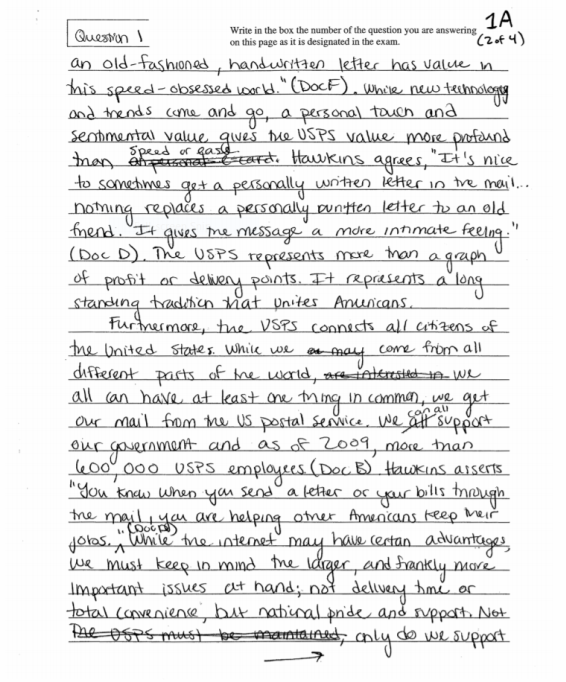
Through a methodical process of presenting topic sentences, supported with quotes, facts, opinions, and discussion, the A writer demonstrates keen reasoning and composition skills. The essay proceeds logically from the introduction to the conclusion with well-chosen details and proper sourcing to make the student’s points clear. For example, the writer’s order proceeds from the importance of the USPS to the suggested USPS revisions. Throughout, transitions (“furthermore”) reinforce the relationships between paragraphs.
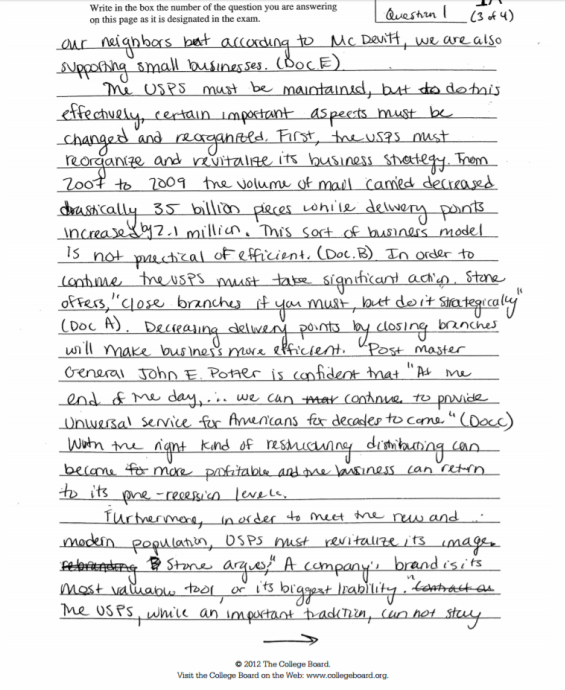
The mid-range sample, on the other hand, struggles to maintain clarity and consistency. Like the A essay, the B essay body paragraphs contain a topic sentence and examples, but the writer explains some examples (the first body paragraph’s point about extending services) but no others (hiring commission and specialized workers). Additionally, the student cites sources inconsistently. The writer doesn’t stick to the A formula of assertion, support, and citation, but generalizes and omits discussion of the main points in support of the claim.
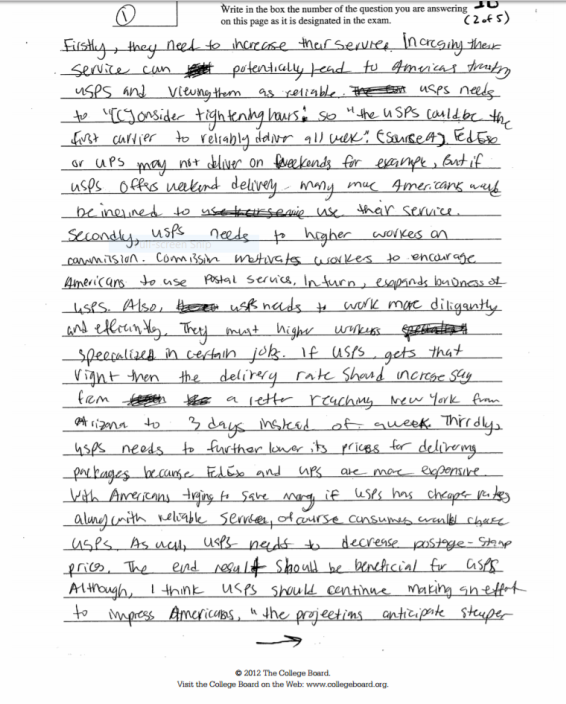
As the CollegeBoard warns, you don’t want merely to summarize sources. The B response does just that in the second body paragraph. Instead of using the source to support the idea that letters are still a source of joy the USPS offers, “to keep in touch with family and friends,” the writer uses anecdotal experience (“I know I’m fiercely tearing away at the envelope”) and summarizes the D source. Moreover, the source is not used authoritatively to support the second point to the claim since the writer just incorporates it into a personal story.
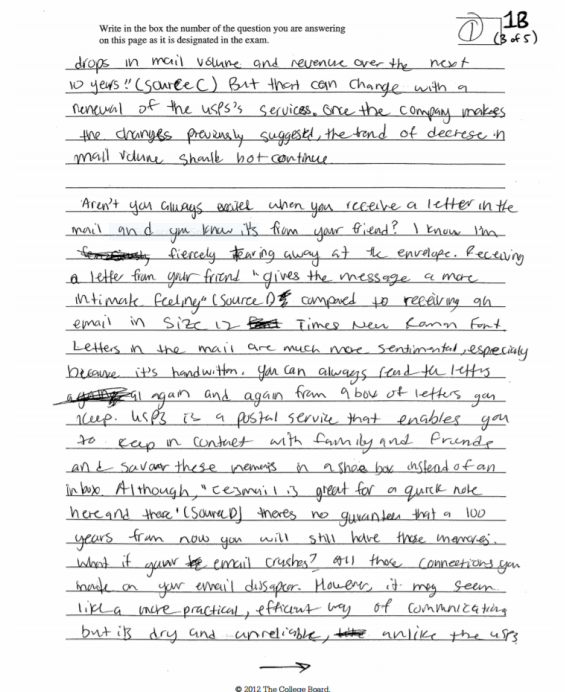
Sample C needs fully developed, clear topic sentences throughout the essay. The first body paragraph starts with an assertion that letters are much more significant as a reason to keep the USPS unchanged. To illustrate, the writer provides: “You can actually feel, hold, and touch a handwritten letter…” without explaining how that’s significant. There’s no discussion tying the example to the topic sentence. Also, all three words–feel, hold, and touch–waste precious time by repeating the same thing (you can feel a letter not an email).
Write a Brief Conclusion
Conclusions leave the reader satisfied and give the writer one last opportunity to cement the argument points and claim in the reader’s mind. If you run out of time, however, omitting the conclusion is not as fatal to your score as writing thin, underdeveloped, disorganized body paragraphs. A quick one or two sentence recap, like the A sample, rounds out thorough preceding paragraphs when nearing the time cut-off.
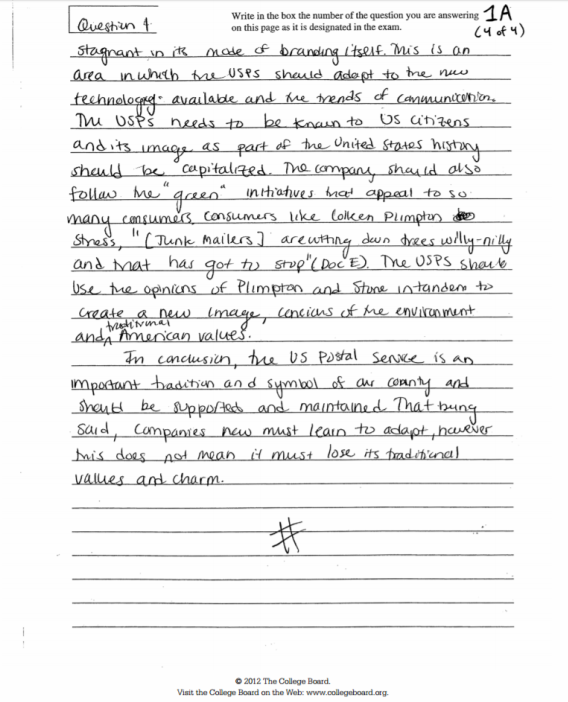
The A response uses the conclusion to tie together succinctly the three points of the preceding paragraphs: the USPS as tradition, the USPS as symbol, and the USPS modernized but not lost. The writer achieves the dual purpose of recapping and reminding the reader of the claim in the introduction without repeating the claim verbatim.
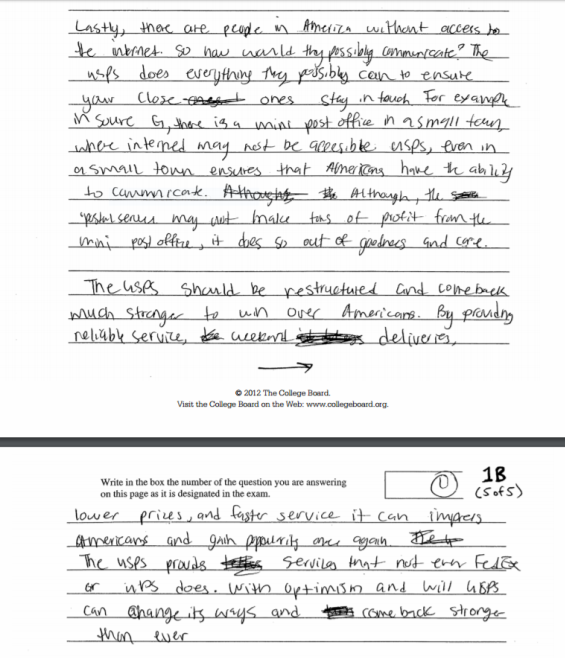
Conclusions are not for introducing new ideas or points not previously discussed in the body paragraphs. The B essay recaps some but not all points made in the essay but also presents the fact that the USPS provides services other carriers don’t. The disorderly ending doesn’t persuade as well as the A’s shorter but clearer restatement, although it is better than C’s vague opinion that doesn’t restate the claim, propose action, or tie up the essay.
Finally, a conclusion compositionally rounds out your essay so that your reader doesn’t struggle with any part of your essay. By repeating recapped points or fleshing them out with insights, you help the reader pull the argument together and wrap up.
Free Response Question #2
The 2012 AP® English Language and Composition exam, Free Response Question 2, required test takers to read the given commentary by John F. Kennedy from a 1962 news conference and write an essay that does the following:
- Analyze Kennedy’s rhetorical strategies used to achieve his purpose (the assumption being you identify the purpose).
- Support the analysis with “specific references to the text”.
Whereas the first FRQ required test takers to synthesize broad ideas, facts, and writing points in three sources (or portions of them) as support, this second question is different. It requires a closer reading and analysis of one source, forcing writers to tease out meaning from the fewer words and facts in a page and a half commentary.
Introduction and Thesis Statement
The a essay.
The writer packs the first sentence with strong verbs (“condemned,” “appeals”), details (“raising steel prices”), description (“communal sacrifice,” “collective responsibility,” and “every man audience”), and direction (claim: Kennedy exhorts “outrage” over raised steel prices).
Then, the student identifies the rhetorical stance of the speaker, Kennedy, with one of the “185 million Americans” against the “handful” of greedy “steel executives” and establishes the tone of the argument as “righteous indignation”.
The sophisticated vocabulary, confident weaving of source facts, and keen analytical ability (astute observation about the point of view) lend credibility to the writer’s argument immediately.
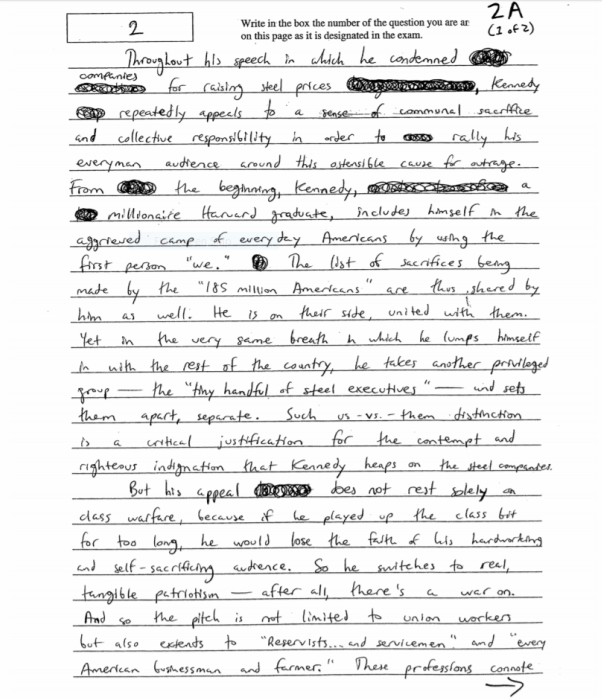
The B Essay
Unlike the economy of the A essay, the B response uses one sentence of a short introduction to repeat the prompt. While the introduction adequately covers the claim and rhetorical strategies, it does so without as much specificity as the A response, opting instead for vague language (“strong diction”) and off-the-mark tone description (Kennedy’s a little more than “disappointed”). By the end of the introduction, the reader understands the essay will touch on tone and diction in analyzing Kennedy’s posited aim to get the steel companies’ price reversal.
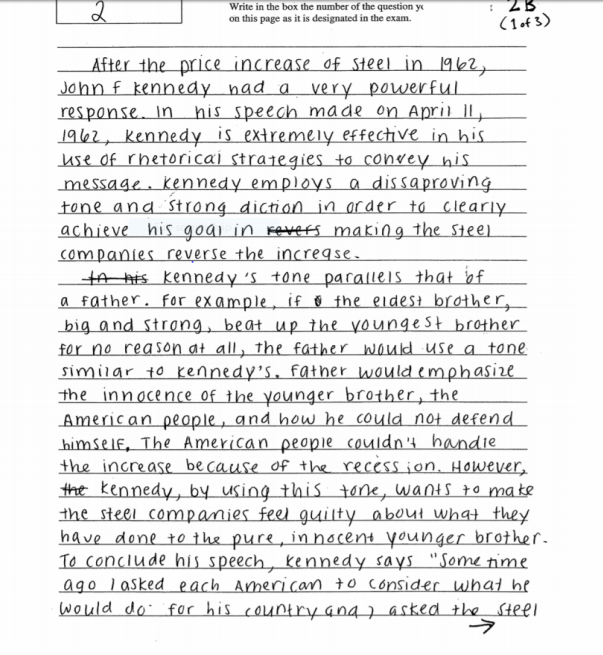
The C Essay
The C introduction lacks specificity and focus. It does not include a claim or address what’s required by the directions. The “it” in “JFK… was able to present it in a way that it was accessible” has no antecedent (what does the “it” refer to?), and the sentence, like the entire introduction, is vague and unclear. The writer shows little understanding of the meaning of “rhetorical strategies”.
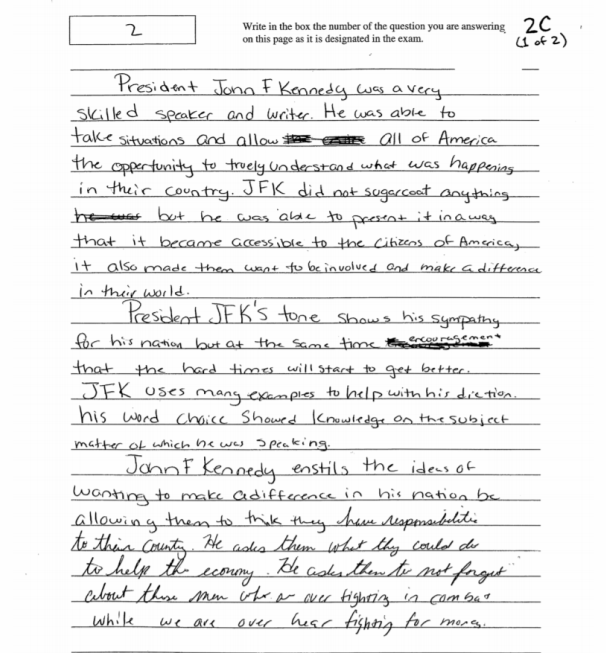
Exemplification, Citation, and Discussion in the Body Paragraphs
Hinging on the word “appeal” from the introduction, the A writer moves in the first body paragraph to Kennedy’s patriotic as well as class appeal. The student cites the text to seamlessly connect the source with the support in a grammatically correct incorporation of quotations into the student’s writing (“but also extends to ‘reservists… and servicemen’”).
The student then expands on the significance of calling upon those specifically addressed in the commentary–servicemen, businessmen, and farmers–to invoke quintessentially American citizens and ideas, hard-working, rugged individualists. The essay proceeds in this highly succinct, fluid pattern of drawing on source language to further each point until the end.
Throughout the body paragraphs, the writer demonstrates confidence and control over language, ideas, and composition skills. The student analyzes methodically, pulling out specific words and devices (“rhetorical caution” in the third paragraph) to reach complex conclusions synthesized from the passage’s language. No statement is left unexplained, and each paragraph begins with a pinpoint focused topic sentences bolstered by transition words that logically connect sentences and paragraphs to cohere all paragraphs to the claim.
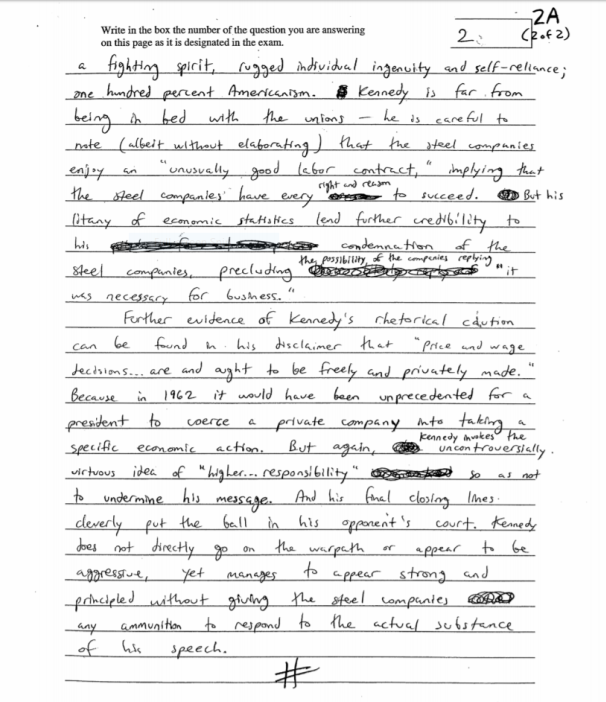
The first body paragraph begins with the “disappointing tone” from the introduction, a good segue into the body of the essay. However, the writer then spends too much time on an analogy between a parent and Kennedy to the nation, taking up valuable time that could be used to incorporate sources in making the point about tone. The first quoted excerpts come mid-way through the paragraph. The student could have spent more time explaining how the quoted language connotes disappointment rather than continue the hypothetical parent example, which dilutes the point. The essay clearly lacks the compactness of the A model.
The broad language, like “well-chosen diction,” and “exceptional word choice” leave the readers scratching their heads to the meaning. The examples of exceptional words “utter contempt” and “tiny handful” don’t clarify the point. The reader must glean the student’s assertion that the diction is effective since there’s no explanation.
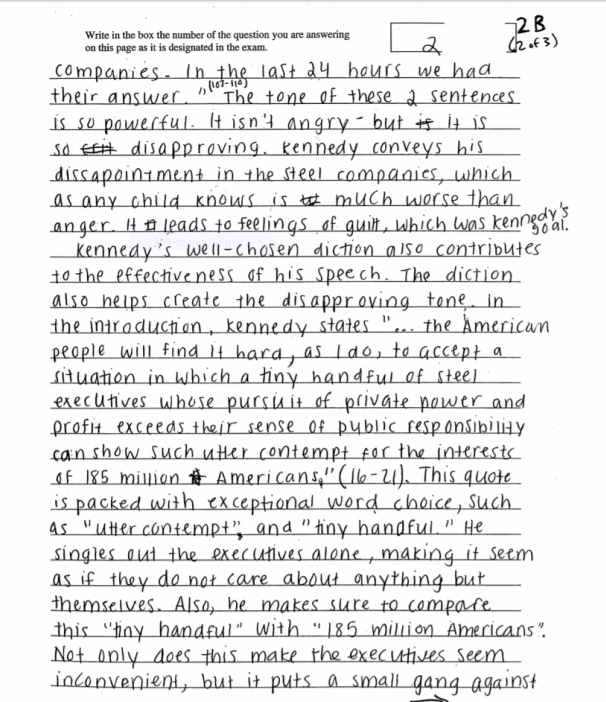
This essay is a shallow analysis, using no direct quotation or specific reference to the commentary until the final body paragraph when the writer finally tackles rhetorical strategies, such as repetition and a restatement of the “Ask not what your country can do for you” reference. The essay primarily summarizes the text content and mentions rhetorical devices but doesn’t exemplify “listing” and “details”. The writing also contains many spelling errors.
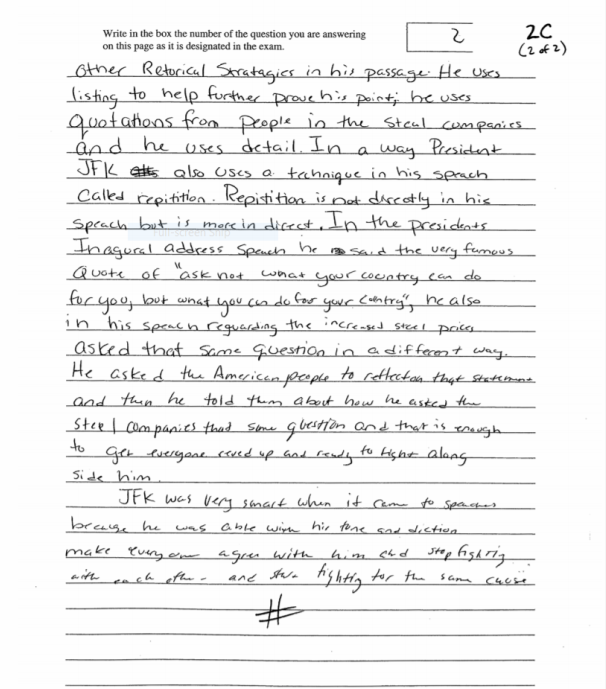
Conclusions
None of the essays make grand conclusions, but only the A essay ends concurrently with the writer’s final point and JFK’s parting remark. The other two end with brief paragraphs, the B restating the claim in a sentence and the C winding up with admiration for JFK’s ability to stop people from fighting, a random point. Even though the A essay doesn’t devote a separate paragraph to conclude, it does leave the reader with a sense of completion, ending with the final point in the essay synced to the overall effect of Kennedy’s speech as strong without capitulating.
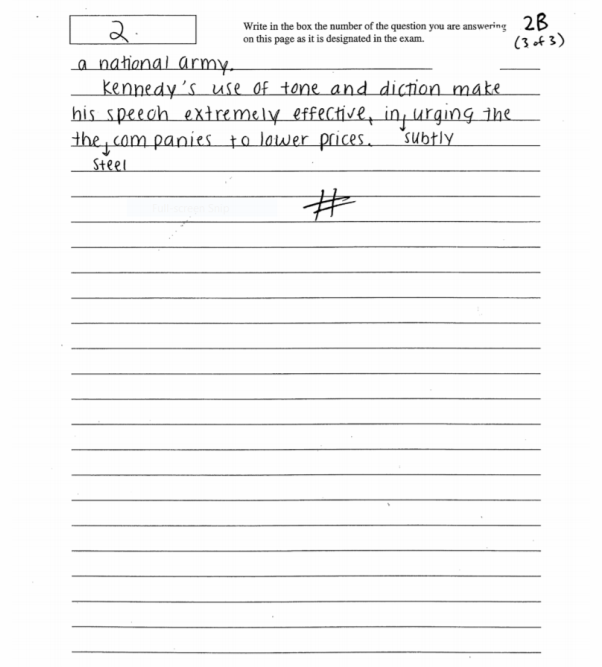
The Free Response Question #3
The year’s third question poses two quotations, one by William Lyon Phelps, educator, journalist, and professor, and the other by Bertrand Russell, British mathematician, writer, and philosopher, on the nature of certainty and doubt. The prompt requires examinees to write an essay that
- Defends a position about the relationship of doubt and certainty
- Supports the argument with appropriate evidence and examples
Broader than the two preceding questions, this open question requires the student to draw on personal experience or the world to demonstrate the ability to concretize two abstract terms with examples and explanation. The attention to detail, economy, and specificity are critical to successfully anchoring the words to concrete examples. Writers must resist the temptation to define abstract terms with generalizations and vague ideas.
Introductions and Thesis Statements
The top essay gets right to the heart of defending a position. It defends a relationship of certainty to doubt by alluding to the first quotation in summary fashion–certainty is the key to achieving your dreams. The writer then moves on to doubt by first defining it, and then showing its relationship to certainty: “Doubt is what allows us to question and challenge those certainties”. The final sentence of the introduction contains the claim, which all of the preceding sentences lead to in an organized and clear opening to the essay.
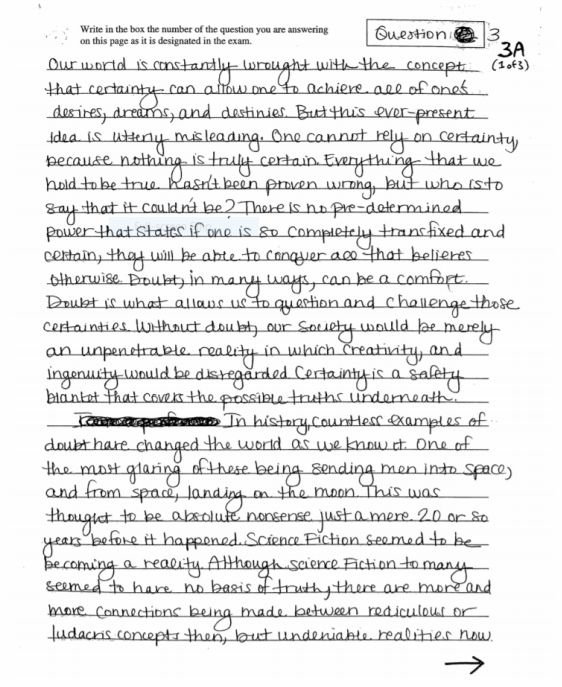
Like the B responses of the two prior sections, the introduction lacks a clear organization, and the language is vague and loose. This short introduction starts out strong by acknowledging a truth about certainty and how doubt fits into that truth. However, by the last sentence, the apparent claim, the ideas become unclear, awash in vague terms like, “the right times,” or “certain times” and entangled in a wordy sentence (“to show through as a more prominent feeling”). Without a clear thesis statement or claim, the reader is unsure where the essay will go.
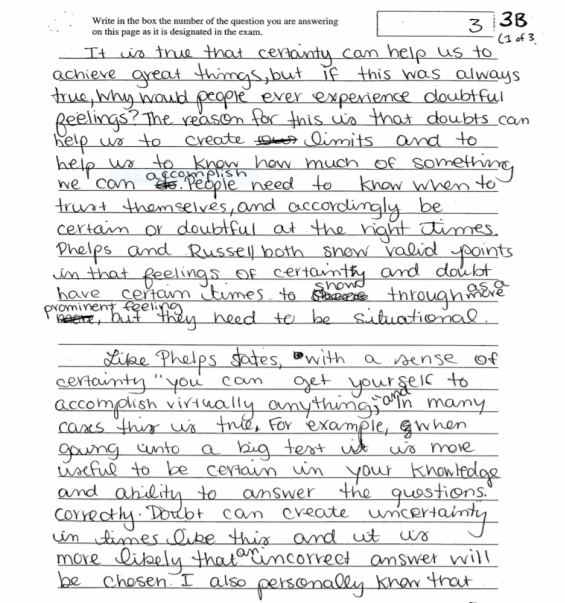
The third introduction melds into the entire essay, which is one page-long paragraph. The first sentence promises to tackle the certainty concept, but it immediately turns to agreeing with the Phelps quote with one personal anecdote as proof. It’s difficult to decipher where the introduction ends and the essay body begins.

Exemplification and Discussion
Like the model essays before it, this sample successfully organizes each paragraph with a clear topic sentence that seamlessly connects with the preceding paragraph (“In history, countless examples of doubt have changed the world” connects with the last sentence in the introduction about “doubt”).
The next order of business after introducing the claim is locating examples that illustrate the relationship between certainty and doubt. The A writer chooses history. The topic sentence encompasses the main idea that history shows significant instances of doubt, and the following sentences prove that assertion with details about moon landings and other seemingly fictional possibilities that turn into reality. The student elaborates on the idea in a full paragraph that makes the topic sentence clear.
The A essay also contains clear transitions to connect paragraphs together and paragraphs to the thesis statement. For example, the second body paragraph begins, “One of the most important components of doubt is trial and error”. In defending the claim, the writer teases out the meaning and character of doubt.
After exemplifying with Thomas Edison’s discovery based on trial and error, the writer goes on to “another example,” which starts off the final body paragraph. The trail from thesis statement to conclusion is methodical and organized. The order of least to most important–technological advancements to religion–leaves the reader with a strong impression of the writer’s compositional capability and keen insights.
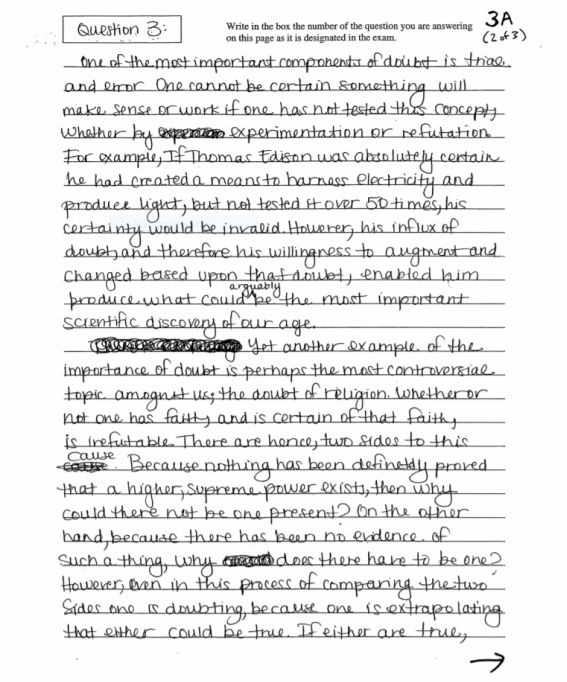
This response also contains insights about the relationship of certainty and doubt (sometimes doubt can mean the difference between living and dying) and examples from history and literature, but the explanations that connect the examples to the point of each paragraph are unclear. The writer uses vague language (“in certain circumstances,” “the right mindset,” “in a bigger, more important view” and less obvious facts (the confidence of the colonists). However, the B writer gets the job done though not without some confusion and work on the reader’s part.
The last example from literature had the potential to exemplify the necessity for doubt, but the reader who hasn’t read the referenced book doesn’t know what the main character did or did not do in the name of confidence. The example is not obvious without a one sentence contextual summary of the character’s behaviors that led to his death might have strengthened the example.
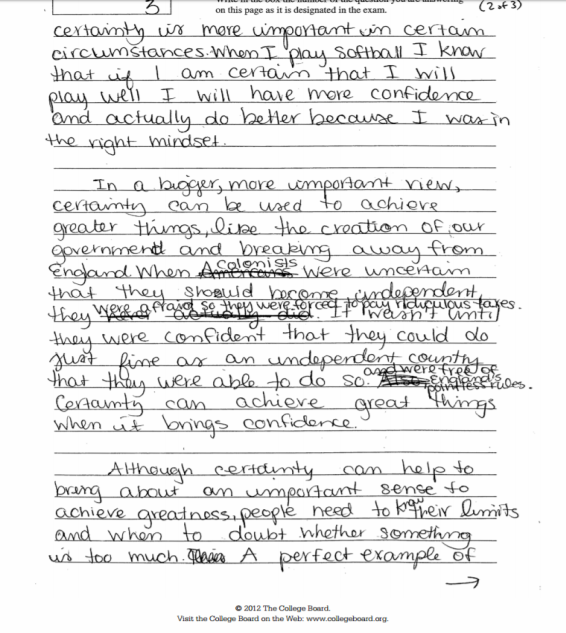
The last example essay uses a personal anecdote of winning a lacrosse game by confidence to agree with the Phelps quote. However, the example is a mere conclusion and a hasty generalization. One incident does not exemplify the broad scope of the quote, which the writer interprets as confidence leads to success.
Without more than a conclusion that the team was confident and the team won, there’s little to no support for the claim, which is that the writer agrees with the Phelps quote. More explanation and detail are necessary to make the example illustrative of the relationship between confidence and doubt. The entire essay needed more: content, order, examples, and paragraphs.
All three essays conclude, but the first one clearly does the best job of winding up the argument. The writer uses the conclusion to reinforce and broaden the reach of the claim that doubt compels creativity to other historical figures not mentioned in the body of the essay. All final examples in the A response support the last comments. They don’t open up a new claim or supporting premise. The last line hammers the essential point home declaratively.
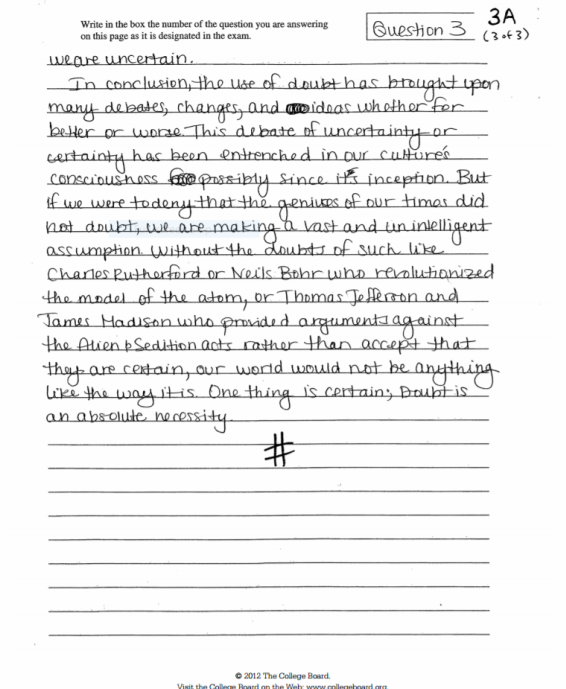
The B and C conclusions, however, don’t satisfy. Consistent with the rest of the essay, the B essay ends vaguely with broad terms that don’t form clear images or ideas: “appropriate time,” “achieve great things,” and “limits available to a person”. The writer needed to specify what’s appropriate, which things, and rephrase “limits available” as the phrase makes little sense. However, the C essay does worse, shifting into second person point of view to instruct the reader in the end. The writer veers off course and doesn’t, in fact, conclude the essay started in the introduction.
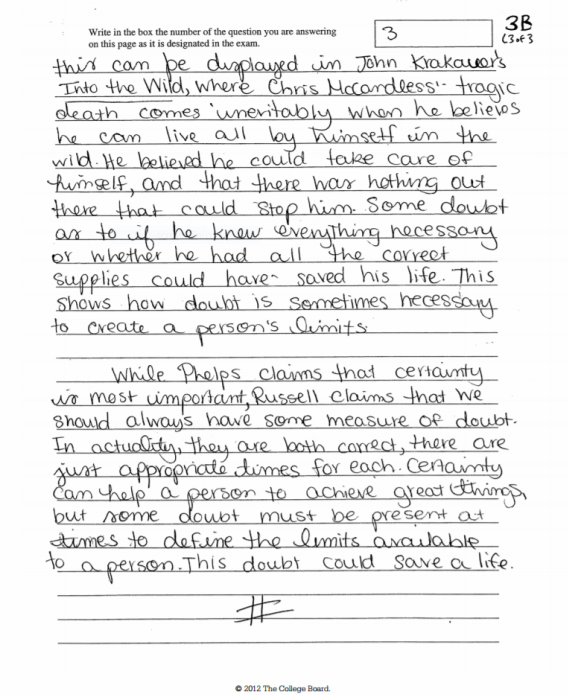
Write in Complete Sentences with Proper Punctuation and Compositional Skills
As you can see from all nine samples, writing counts–heavily. Though pressed for time, it’s important to write an essay in concise sentences with words both precise and economical. Choosing strong verbs and adjectives vivify and crystallize your ideas. Fragments and misspelled words cause confusion and weaken your argument. Additionally, sound compositional skills create a favorable impression on the reader.
You want your essay to read smoothly, without the reader having to re-read sentences to figure out what you mean. Using appropriate transitions or signals (furthermore, therefore) to tie sentences and paragraphs together solidifies relationships between sentences and paragraphs (“also”–adding information, “however”–contrasting an idea in the preceding sentence), making your essay organized and clear.
Starting each paragraph with a clear topic sentence that previews the main idea or focus of the paragraph helps both writer and reader keep track of each part of the argument. Each section furthers your points on the way to convincing your reader of your argument. If one point is unclear, unfocused, or grammatically unintelligible, like a house of cards, the entire argument crumbles. Excellent compositional skills help you lay it all out orderly, clearly, and completely.
So by the time the conclusion takes the reader to your parting words, you have done all of the following:
- followed the prompt
- followed the propounded thesis statement in exact order promised
- provided a full discussion with examples
- included quotes, paraphrases, and citations, proving each assertion
- used clear, grammatically correct sentences
- written paragraphs ordered by a thesis statement
- created topic sentences for each paragraph
- ensured each topic sentence furthered the ideas presented in the thesis statement
Have a Plan and Follow it
It takes discipline to lay out an order, a strict time limit for each essay, and stick to them. To score high on the AP® Language and Composition FRQs, practice planning responses under tight time constraints. Write as many practice essays as you can. Follow the same process each time.
First, be sure to read the instructions carefully, highlighting, circling, or underlining the parts of the prompt you absolutely must cover. Then quickly pencil a scratch outline of the order you intend to cover each point in support of your argument. You should write a clear thesis statement, written as a complete sentence, as well as the topic sentences to each paragraph. Then quickly write underneath each topic sentence, the quotes and details you’ll use to support the topic sentences. Then refer to your outline often and follow it faithfully.
Be sure to give yourself enough time to review and revise. Give your essay a brief read over to catch mechanical errors, missing words, or necessary insertions to clarify an incomplete or unclear thought. With time, an organized approach, and plenty of practice, earning high scores on the AP® English Language and Composition FRQs is attainable. Be sure to ask your teacher or consult other resources, like albert.io’s English Literature practice essays, if you’re unsure how to identify poetic devices, prose elements, or just need more practice writing literary analyses.
Looking for AP® English Language practice?
Kickstart your AP® English Language prep with Albert. Start your AP® exam prep today .
Interested in a school license?
Popular posts.

AP® Score Calculators
Simulate how different MCQ and FRQ scores translate into AP® scores

AP® Review Guides
The ultimate review guides for AP® subjects to help you plan and structure your prep.

Core Subject Review Guides
Review the most important topics in Physics and Algebra 1 .

SAT® Score Calculator
See how scores on each section impacts your overall SAT® score

ACT® Score Calculator
See how scores on each section impacts your overall ACT® score

Grammar Review Hub
Comprehensive review of grammar skills

AP® Posters
Download updated posters summarizing the main topics and structure for each AP® exam.

Crafting a Powerful Argument in AP Language Essays

The AP Language exam requires students to not only comprehend complex texts but also to construct compelling arguments in their essays. Mastering the art of crafting a powerful argument is essential for success. Here's a guide to help you enhance your argumentative writing skills:
1. Understanding the Prompt:
- Begin by carefully analyzing the essay prompt. Identify the key components, including the rhetorical strategies to be discussed or the specific type of argument to be made.
2. Thesis Statement:
- Craft a clear and concise thesis statement that outlines the main argument of your essay. Ensure it directly addresses the prompt and sets the tone for your analysis.
3. Evidential Support:
- Support your argument with relevant evidence from the text. This can include quotations, paraphrases, or specific examples that illustrate your points.
- Use a variety of evidence types, including facts, statistics, anecdotes, or expert opinions, to strengthen your argument.
4. Understanding Rhetorical Strategies:
- Familiarize yourself with common rhetorical strategies such as ethos, pathos, logos, and devices like parallelism, irony, and metaphor.
- Identify these strategies in the text and explain how they contribute to the overall effectiveness of the argument.
5. Appealing to Your Audience:
- Consider your target audience and tailor your argument to appeal to their values, emotions, and beliefs.
- Anticipate potential counterarguments and address them to strengthen your overall persuasive appeal.
6. Logical Organization:
- Structure your essay with a clear introduction, body paragraphs, and conclusion.
- Ensure a logical flow of ideas, with each paragraph building on the previous one and contributing to the overall argument.
7. Effective Transitions:
- Use transitions to connect ideas and guide the reader through your argument seamlessly. This enhances the overall coherence of your essay.
8. Sophisticated Language Use:
- Demonstrate a command of language by using varied and precise vocabulary.
- Pay attention to sentence structure and syntax to convey your ideas with clarity and sophistication.
9. Critical Analysis:
- Move beyond surface-level analysis. Instead, delve into the deeper meaning of the text and the author's rhetorical choices.
- Offer insights into how these choices contribute to the author's purpose and the effectiveness of the argument.
10. Revision and Editing:
- Set aside time for revision and editing. Review your essay for clarity, coherence, and grammatical correctness.
- Seek feedback from peers or teachers to gain different perspectives on the strength of your argument.
11. Consistent Tone:
- Maintain a consistent tone throughout your essay. Whether formal, informal, or a combination, ensure it aligns with your rhetorical purpose.
12. Time Management:
- Practice efficient time management during the exam. Allocate time for planning, writing, and revising to ensure a well-crafted argument within the given timeframe.
By honing your ability to construct a compelling argument, you'll be well-prepared to tackle the essays in the AP Language exam. Remember to practice regularly, seek feedback, and continuously refine your skills.
You Might Also Like

Guidelines To Write Impressive High School Resume
Know some important guidelines will help you write an effective high school resume that will stand out in the crowd. Check out resume sample here

Brainstorming for College Essays
This Article is intended to help you brainstorm and begin writing your personal statement essay and all the other college essays. This is a key step to write persuasive college essays

A Brief Introduction to College Scholarships
Do you know how to win college scholarship? Know detail information about college scholarship & how to get scholarship successfully? - Read our blog carefully

Free Resources
Argument Essay: Evidence
9 min read • june 18, 2024
Stephanie Kirk
We aren’t sure where it started, but many teachers use REHUGO to help students find evidence on the Argument FRQ . This acronym provides a quick check that can help you build logical evidence that supports your claim .
- R - Reading - Something you have read, fiction or nonfiction, that connects the given topic.
- E - Entertainment - A movie or song with dialogue or lyrics that present related ideas.
- H - History - An event, document, speech, or person from history that aligns with the given topic.
- U - Universal Truths - A common maxim or socially-accepted quote people tend to accept as truth.
- G - Government - A national or international current event or governmental situation related to the topic.
- O - Observations - Any cultural, technical, or societal trend that relates to the topic.
Suggested Guided Questions for the Argument FRQ
Now that you have a better understanding of the Argument FRQ’s expectations and scoring, let’s visit a sample prompt and add a few guided questions that you can use to help plan your own writings.
| In his book Canadian journalist Malcolm Gladwell (born 1963) writes: “To assume the best about another is the trait that has created modern society. Those occasions when our trusting nature gets violated are tragic. But the alternative—to abandon trust as a defense against predation and deception—is worse.”Write an essay that argues your position on the importance of . |
Guided Question 1: What does the prompt say? 📝
- Why do I do this? Understanding the concept or idea presented by the prompt is vital to planning a response that thoroughly addresses the prompt and stays on topic throughout. This is where you are going to BAT the PROMPT .
- Background : Gladwell asserts that society should trust each other in order to continue to be productive. Assuming the best about each other presents a better outcome than assuming the worst about each other.
- Advice : The new stable prompt wording does not give much advice, but you should revisit advice you learned in class or from us as Fiveable -- things like using Toulmin to plan your response and planning modes of development that help progress your reasoning.
- Task : Write an essay giving your position about the importance of trust. Specifically, is Gladwell right or wrong? And why? 🎥 Watch: AP Lang - Argumentation, Part I: It's a Trap!
Rhetorical Situation : When writing for AP Lang, it is important to consider the rhetorical situation and write in a manner that demonstrates an understanding of all elements of that situation.
- Context - the historical, social, and cultural movements in the time of the text
- Exigence - the urgency that leads to an action
- Purpose - the goal the speaker wants to achieve and the desired audience movement
- Persona - the “mask” shown to his/her audience

Image Courtesy of Dana Anderson, Writing Unleashed
Guided Question 2: What do I think? 💡
Why do I do this? Taking a moment to brainstorm ideas can help organize thoughts and build an outline that you can revisit if you lose your train of thought in the stress of timed writing.
What does it look like? This might just be stream-of-consciousness in your head, cloud diagrams, or even bulleted notes on the side of your prompt, but it needs to end with a clear position statement you can use for your thesis statement . For example: Trust is important. It does suck to get betrayed though but having a positive outlook creates positive results. Thinking the worst makes people act negatively because they project in a way that leads toward the worst response. ⬇️
- Thesis Statement: Although some people believe humanity seems self-interested, a trusting nature enables individuals to focus on the positive and treat others with the respect that foster positive interrelationships.
Guided Question 3: What evidence can I use? 🤔
- Why do I do this? Revisit REHUGO and use Toulmin to plan your body paragraphs based on the thesis statement you came to when brainstorming ideas.
- Modes of Development: When writing, it is helpful to arrange the overall essay and its parts in a way that aligns with the purpose. Consider these basic modes and how you might use them in writing an argumentative essay.- Cause and Effect attempt to follow the chain of events and establish causation. The description brings imagery and details into a text so that it set up the tone and ensures the reader can follow the mood.- Classification allows the speaker to categorize things in a way that guides the reader to follow the line of reasoning.- Comparison , looking at the similarities and differences, helps to analyze the intricate details of a given topic. Because this describes differing elements, it may be structured by the element or by the characteristic.- Definition works to explain what something is or is not. By defining the subject being discussed, the speaker is able to control the thinking about that subject. Because this helps to clarify the topic, it is generally used in the introductory section of argumentation.- Exemplification is used when explaining the topic or situation by giving examples to help lead the audience to the desired conclusion.- Narration tells a story or gives an anecdote to help illustrate the point.- Process Analysis serves to explain the process by which something is done.
- What does it look like? I always use a version of the T-chart because one side is my evidence and the other side helps me consider multiple perspectives. You may not have an idea in all areas, and you may have multiple ideas in one area. Try to time yourself so that you get plenty of strong evidence without wasting too much time. | Supports 🏗️ | Thoughts 💭 | | --- | --- | | ~ R - Trust in Society by Cook points out that we only realize the importance of trust when there’s a breakdown.~ R - Essay “Importance of Trust” from class said that trust is not easy but it is what builds the foundation of a relationship and drives all actions between sides.~ E - The 2011 movie Trust shows that too much trust can get you hurt or killed.~ E - The media has so much bias it can’t be trusted… ~ H - Revolutionary War - trusted founding fathers and God’s position resulting in breaking free from Britain~ U - Trust - People should be trusted until proven otherwise~ G - A criminal escaped in our town and was on the loose; we trusted police to do their job rather than resort to vigilante justice~ G - Trust the president will have our best interests at heart -- most appear to have done that~ O - App-based dating - relies on trusting the person you meet online before meeting in person | > relationships between couples> trust in contractual agreements? Moral obligation for trust?> Counter?> Relied on trust and won with not much else to go ob> Ex, Parents, Teachers, Siblings > Trust helped keep us safe; job was well done when we were out of the way> Obvious exceptions; System of impeachment |
🎥 Watch: AP Lang - Review: Argument Body Paragraphs
PRO TIP: What if you have more evidence for the other side? Well, you haven’t started writing just yet, so it isn’t too late to go back and revise the thesis statement. Sometimes this happens in looking for evidence, and that’s perfectly okay. In fact, many times students will say they wrote an essay using evidence that went completely against what they felt in their head or heart just because they couldn’t put a logical argument on paper without getting too emotional. Know your audience, and build your argument.
Guided Question 4: How should I effectively organize my response? 📈
- Why do I do this? This step helps to outline the response so that your ideas are organized before you start writing. The general advice is to follow the structure of Classical Argumentation , but there is no rule saying that must be done to score well on the rubric. 💯
- What does it look like? One way of doing this would be to mark numbers by ideas tracked and written in the brainstorm, but some do take a moment to build an outline with topic sentences.
- Modes of Development: When writing, it is helpful to arrange the overall essay and its parts in a way that aligns with the purpose. Consider these basic modes and how you might use them in writing an argumentative essay.- Cause and Effect attempt to follow the chain of events and establish causation. The description brings imagery and details into a text so that it set up the tone and ensures the reader can follow the mood.- Classification allows the speaker to categorize things in a way that guides the reader to follow the line of reasoning.- Comparison , looking at the similarities and differences, helps to analyze the intricate details of a given topic. Because this describes differing elements, it may be structured by the element or by the characteristic.- Definition works to explain what something is or is not. By defining the subject being discussed, the speaker is able to control the thinking about that subject. Because this helps to clarify the topic, it is generally used in the introductory section of argumentation.- Exemplification is used when explaining the topic or situation by giving examples to help lead the audience to the desired conclusion.- Narration tells a story or gives an anecdote to help illustrate the point.- Process Analysis serves to explain the process by which something is done.
- Start by creating Toulmin Position Statements that can be used for topic sentences and then move into a writing plan. Here’s a sample for this prompt:
Sample Outline:
- Revised Thesis: Although some people believe trust must be earned, maintaining a trusting nature is important because it enables society to focus on positivity and create positive interrelationships that lead to positive outcomes.
- Universal truth
- Observation
- Entertainment - refute
- Conclude: When considering the value of trust in society, it is clear that the benefits of granting trust far outweigh the consequences of withholding it.
Key Terms to Review ( 35 )

Stay Connected
© 2024 Fiveable Inc. All rights reserved.
AP® and SAT® are trademarks registered by the College Board, which is not affiliated with, and does not endorse this website.

IMAGES
VIDEO
COMMENTS
Download free-response questions from past AP English Language & Composition exams, along with scoring guidelines, sample responses, and scoring distributions.
In a well-organized essay, take a position on the relationship between certainty and doubt. Support your argument with appropriate evidence and examples. 2011-A. The following passage is from Rights of Man, a book written by the pamphleteer Thomas Paine in 1791.
Question 1. (Suggested time—40 minutes. This question counts for one-third of the total essay section score.) The United States Postal Service (USPS) has delivered communications for more than two centuries.
Ap Lang Argumentative Essay - Expert advice on how to pen a winning essay + an AP Lang argument essay example to guide your writing.
This post goes over how to ace the argument essay on the AP English Language and Composition Exam. We offer tips and break down a couple of example essays.
The student’s argument in this effective essay focuses on the productive power of doubt insofar as it allows for the questioning and challenging of certainties and the stimulation of creativity, ingenuity, and progress.
Writing an argumentative essay for AP Language and Composition requires a strategic approach to effectively convey your perspective. Here's a guide to crafting an impressive argumentative essay: 1. Understand the Prompt: - Tip: Carefully read and analyze the prompt.
To do well on the AP® English Language and Composition exam, you’ll need to write organized, substantive essays. Specifically, you must write an argument defending your position, using sources provided in the Free Response Question section along with your experience and knowledge.
1. Understanding the Prompt: - Begin by carefully analyzing the essay prompt. Identify the key components, including the rhetorical strategies to be discussed or the specific type of argument to be made. 2. Thesis Statement: - Craft a clear and concise thesis statement that outlines the main argument of your essay.
Argument FRQ: An Argument FRQ (Free Response Question) is an essay question on the AP English Language exam that requires students to construct and defend an argument using evidence and rhetorical strategies. Audience: The audience refers to the intended recipients or listeners of a message.